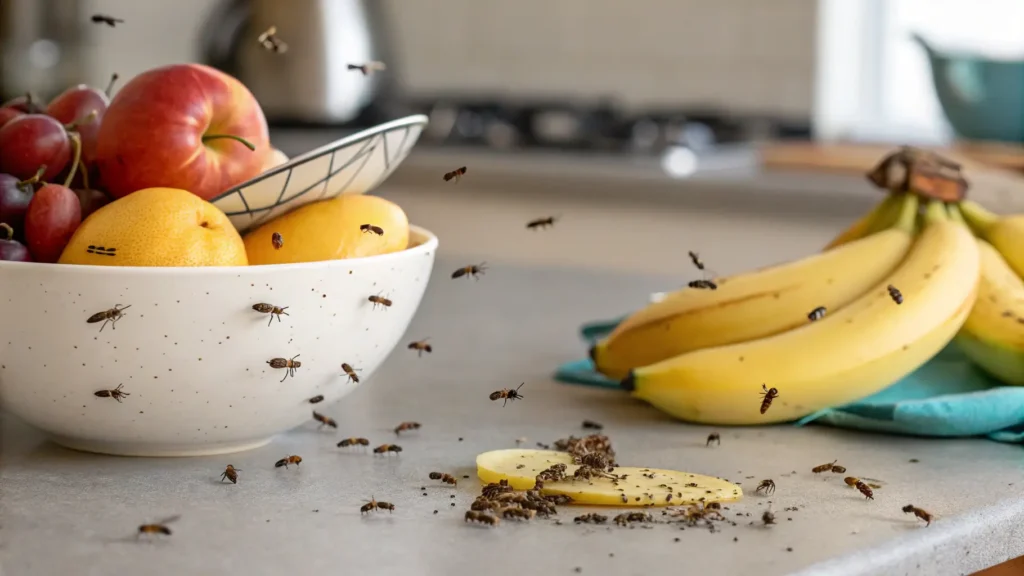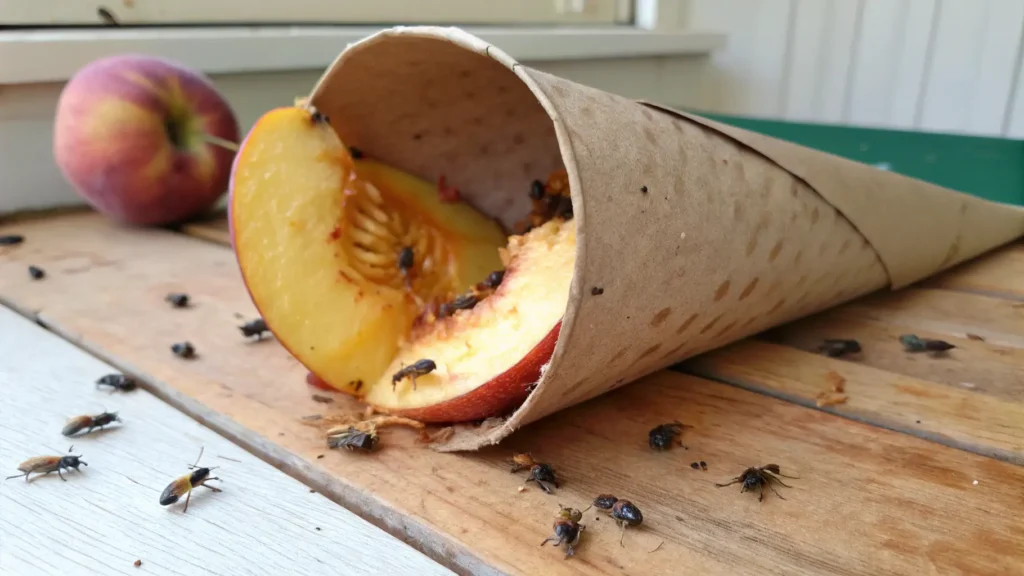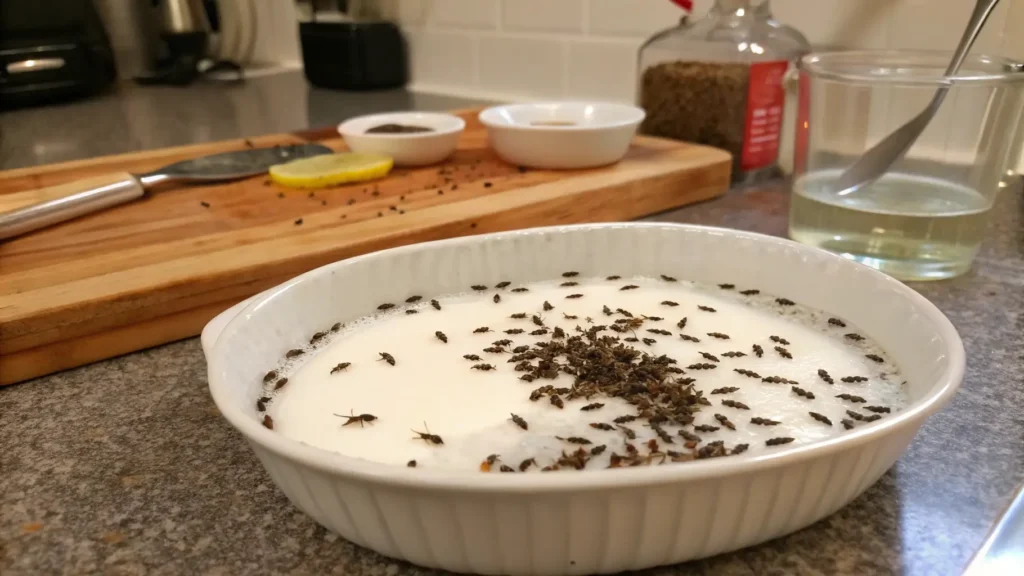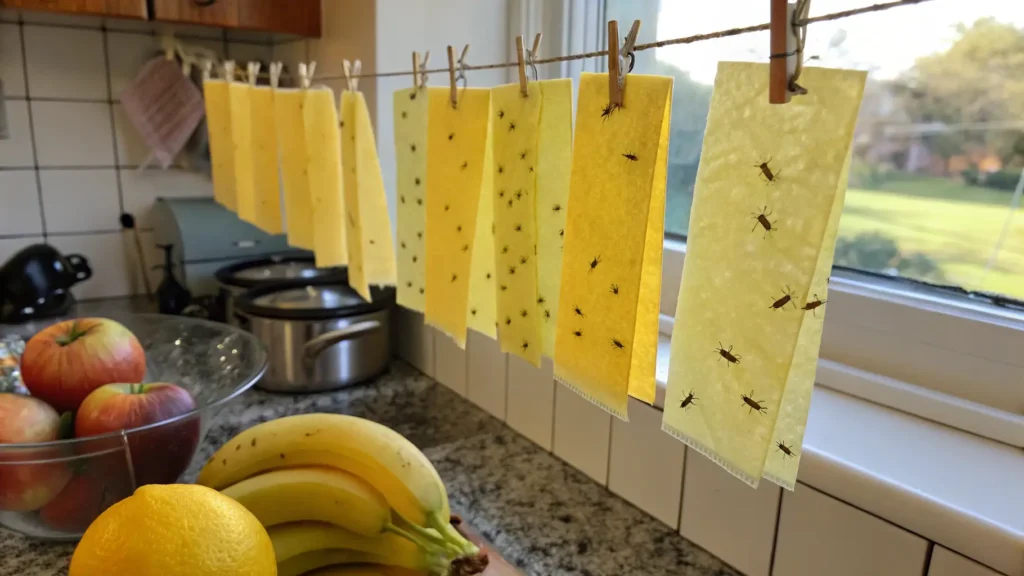Are tiny, buzzing fruit flies taking over your kitchen, swarming your ripe produce, and turning every meal prep into a battle? You’re not alone. These persistent pests can appear out of nowhere, multiplying rapidly and creating a frustrating nuisance. But before you reach for harsh chemicals, discover the power of simple, effective DIY fruit fly traps that leverage common household ingredients.
This comprehensive guide is your definitive resource for not only eliminating active infestations but also understanding why these methods work and how to prevent future invasions. We’ll delve into the science, provide visually rich, step-by-step instructions for 7 proven homemade trap methods, offer an interactive comparison to help you choose the best one, and equip you with advanced prevention strategies. Get ready to reclaim your kitchen and enjoy a fruit fly-free home.
TABLE OF CONTENTS
Quick Start Guide: Your Fastest Fruit Fly Trap Today
Dealing with an immediate fruit fly problem? We’ve got you covered with a lightning-fast solution. This simple trap is highly effective and uses ingredients you likely already have.
Apple Cider Vinegar & Dish Soap Trap:
- Ingredients:
- Small bowl or jar
- 1/2 cup apple cider vinegar (ACV)
- 2-3 drops liquid dish soap
- Warm water (optional, to slightly dilute)
- Steps:
- Pour the ACV into your bowl or jar.
- Add 2-3 drops of liquid dish soap. The soap breaks the surface tension of the liquid, causing the flies to sink.
- Optionally, add a splash of warm water to slightly dilute and make the scent more volatile.
- Stir gently to combine, without creating too many suds.
- Place the trap near areas of high fruit fly activity.
- Estimated Setup Time: Under 1 minute.
- Time to See Results: Within hours.
What Are Fruit Flies & Why Are They in Your Home? (The Basics)
To truly defeat fruit flies, it helps to understand your opponent. Often identified as Drosophila melanogaster, these tiny insects are more than just a nuisance; they are master opportunists.
Key Points:
- Attractants: Fruit flies are primarily drawn to fermenting organic matter. This includes overripe fruits and vegetables, spilled sugary drinks, residual food in drains, and even garbage disposals. The yeast in these items produces alcohol, which fruit flies adore.
- Rapid Life Cycle: A single female fruit fly can lay hundreds of eggs, often directly on or near fermenting food. These eggs hatch into larvae within hours, quickly developing into adult flies. The entire cycle can take as little as 7-10 days, leading to rapid population explosions.
- Common Entry Points: While they can come in on produce from the grocery store, fruit flies also find their way into homes through open windows, torn screens, and even tiny cracks. Once inside, they quickly seek out food and breeding sites.

Did You Know? Fruit flies are prolific breeders! A single pair can produce hundreds of offspring in a week, and a massive infestation can develop from just a few flies in a very short time.
The Science Behind DIY Fruit Fly Traps: How They Attract & Eliminate
Understanding the science makes your DIY fruit fly traps even more effective. It’s not magic; it’s a clever exploit of fruit fly biology.
Key Points:
- Olfaction (Smell): Fruit flies have an incredibly sensitive sense of smell, allowing them to detect the volatile organic compounds (VOCs) produced by fermenting matter from a surprising distance. Acetic acid (found in vinegar), ethanol (in alcohol), and various esters from ripe fruit are powerful attractants.
- Role of Surfactants (Dish Soap): Water has high surface tension, allowing tiny insects to often walk or rest on it. Dish soap is a surfactant, meaning it reduces this surface tension. When fruit flies land on the liquid bait with dish soap, they can’t stay afloat and quickly drown.
- Physical Trapping Mechanisms (Funnel Effect): Many traps utilize a funnel shape (either a paper cone or plastic wrap with holes). This design makes it easy for flies, drawn by the scent, to enter the trap but incredibly difficult for them to find their way back out, effectively caging them.
7 Proven DIY Fruit Fly Trap Methods (Step-by-Step with Pictures)
Here are 7 of the most effective DIY fruit fly trap methods you can easily make at home. Each method includes ingredients, step-by-step instructions, a brief explanation of “Why This Works,” and a handy pro/con summary.
Method 1: Apple Cider Vinegar & Dish Soap Trap
This classic trap is a go-to for its simplicity and effectiveness.
- Ingredients:
- Small bowl, jar, or glass
- 1/2 cup apple cider vinegar (ACV)
- 2-3 drops liquid dish soap
- Plastic wrap (optional)
- Rubber band (optional)
- Steps:
- Pour the ACV into your chosen container.
- Add the dish soap and gently stir to combine without making too many bubbles.
- Optional Enhancement: Cover the top tightly with plastic wrap and poke 3-5 small holes (about pencil-tip size) into the plastic. Secure with a rubber band. This creates a funnel effect.
- Place the trap near fruit fly activity.

- Why This Works: The ACV’s acetic acid strongly mimics the smell of fermenting fruit. The dish soap reduces the surface tension, causing flies to sink and drown. The optional plastic wrap funnel makes escape difficult.
- Pros & Cons:
- Pros: Highly effective, uses common ingredients, very quick to set up.
- Cons: Can be messy if spilled, visible dead flies.
Method 2: Red Wine/Beer Trap
Don’t let that last sip of wine go to waste; it’s a potent fruit fly magnet!
- Ingredients:
- Wine bottle or small jar
- A splash of red wine or stale beer (about 1/4 cup)
- 2-3 drops liquid dish soap (optional, but recommended)
- Steps:
- Pour the red wine or stale beer into the bottle or jar.
- (Optional) Add 2-3 drops of dish soap to break surface tension.
- Place the bottle/jar directly in the infested area. The narrow neck of a wine bottle often acts as a natural funnel, trapping flies.
- Why This Works: Like fruit, alcoholic beverages contain ethanol, a powerful attractant for fruit flies. The natural yeast and fermentation odors further entice them. The narrow neck of a wine bottle physically traps them.
- Pros & Cons:
- Pros: Very effective, especially with wine bottles; uses leftover drinks.
- Cons: May require a specific container (wine bottle), can attract pets if placed improperly.
Method 3: Overripe Fruit & Funnel Trap
Embrace what attracts them the most: actual fruit!
- Ingredients:
- Small bowl or jar
- A few pieces of very overripe fruit (e.g., banana peel, apple core, melon rind)
- Paper
- Tape
- 2-3 drops liquid dish soap (optional)
- Steps:
- Place the overripe fruit at the bottom of the bowl or jar.
- Roll the paper into a cone shape, ensuring the small opening at the bottom is just large enough for a fruit fly to enter. Tape the cone to secure its shape.
- Place the wide end of the paper cone into the jar, ensuring there are no gaps around the rim.
- (Optional) Add a few drops of dish soap to the fruit.

- Why This Works: The natural sugars and fermentation odors from the decaying fruit are irresistible to fruit flies. The paper cone acts as a one-way street, allowing them in but preventing escape.
- Pros & Cons:
- Pros: Utilizes natural attractants, highly effective, very low cost.
- Cons: Can be less visually appealing, requires fresh overripe fruit.
Method 4: Plastic Wrap & Dish Soap Trap
A simple variation that uses household plastic wrap to create a powerful trap.
- Ingredients:
- Glass or bowl
- Sweet liquid (fruit juice, soda, balsamic vinegar, ACV)
- 2-3 drops liquid dish soap
- Plastic wrap
- Rubber band
- Steps:
- Fill the glass with about an inch of your chosen sweet liquid.
- Add 2-3 drops of dish soap.
- Cover the top tightly with plastic wrap and secure with a rubber band.
- Poke several very small holes (pencil tip size) into the plastic wrap.
- Why This Works: The sweet liquid attracts the flies, and the dish soap ensures they drown. The plastic wrap acts as a physical barrier, making it difficult for flies to find the small exit holes.
- Pros & Cons:
- Pros: Uses readily available materials, effective, easy to monitor.
- Cons: Can be tricky to get the right hole size, visible contents.
Method 5: Yeast & Sugar Trap
This method harnesses the power of active fermentation to lure fruit flies.
- Ingredients:
- Small bowl or jar
- 1/2 cup warm water
- 1 teaspoon sugar
- 1/2 teaspoon active dry yeast
- 2-3 drops liquid dish soap (optional)
- Steps:
- In the bowl, dissolve the sugar in the warm water.
- Stir in the active dry yeast. The mixture will start to bubble as the yeast ferments.
- (Optional) Add 2-3 drops of dish soap.
- Place the trap near infested areas. The fermentation process produces carbon dioxide and ethanol, both strong fruit fly attractants.
- Why This Works: The active yeast fermentation creates alcohol and CO2, mimicking the intense attractants of highly fermenting fruit. This makes it a very potent lure.
- Pros & Cons:
- Pros: Extremely effective due to strong fermentation, uses basic baking ingredients.
- Cons: May need to replace daily for peak effectiveness, visible bubbling.
Method 6: Milk, Sugar, & Pepper Trap
An older folk remedy that some swear by, offering an alternative to vinegar.
- Ingredients:
- Small saucepan or shallow dish
- 1 pint milk
- 1/4 cup sugar
- 2 ounces ground black pepper
- Steps:
- Combine the milk, sugar, and ground pepper in a saucepan.
- Simmer gently on low heat for 10 minutes.
- Pour the cooled mixture into a shallow dish. Fruit flies will be attracted, land, and drown.

- Why This Works: The exact science is debated, but it’s believed the sweetness attracts, and the milk’s proteins combined with pepper may make it difficult for flies to escape once they land.
- Pros & Cons:
- Pros: Non-vinegar option, simple ingredients.
- Cons: Less scientifically proven effectiveness than other methods, takes longer to prepare.
Method 7: Vinegar Fly Paper Strips (DIY Version)
A creative twist on traditional fly paper, using vinegar as the attractant.
- Ingredients:
- Brown paper bag or thick paper strips
- 1/2 cup apple cider vinegar (or other strong attractant)
- 1 tablespoon sugar
- 2 tablespoons corn syrup or honey
- String or ribbon
- Steps:
- Cut the paper bag into strips, about 1-inch wide and 8-10 inches long. Punch a hole at one end of each strip and thread a string through.
- In a shallow dish, mix the ACV, sugar, and corn syrup/honey thoroughly.
- Dip each paper strip into the mixture, ensuring it’s fully coated. Let excess drip off.
- Hang the sticky strips in areas where fruit flies congregate, but away from food preparation.

- Why This Works: The sticky syrup physically traps flies upon contact, while the vinegar and sugar act as strong lures.
- Pros & Cons:
- Pros: Environmentally friendly alternative to commercial fly paper, highly visible results.
- Cons: Can be very messy, less effective than direct drowning traps, aesthetically unappealing.
DIY Fruit Fly Trap Comparison: Which Method is Best for You?
Choosing the right DIY fruit fly trap depends on your priorities: speed, cost, ingredients on hand, and safety. This comparison table helps you make an informed decision.
| Method | Effectiveness (1-5, 5=Highest) | Ease of Setup (1-5, 5=Easiest) | Required Ingredients | Cost | Time to See Results | Safety (Pets/Kids) |
|---|---|---|---|---|---|---|
| 1. ACV & Dish Soap | 5 | 5 | Common | Low | Hours | Generally Low |
| 2. Red Wine/Beer Trap | 4 | 4 | Common | Low | Hours | Medium (alcohol content) |
| 3. Overripe Fruit & Funnel | 4 | 3 | Common | Very Low | Hours | Low (if kept away) |
| 4. Plastic Wrap & Dish Soap | 4 | 4 | Common | Low | Hours | Generally Low |
| 5. Yeast & Sugar Trap | 5 | 3 | Common (baking) | Low | Hours | Generally Low |
| 6. Milk, Sugar, & Pepper | 3 | 2 | Common | Low | 12-24 Hours | Low |
| 7. Vinegar Fly Paper Strips (DIY) | 3 | 2 | Common (sticky element) | Low | 12-24 Hours | Medium (sticky, can get everywhere) |
- Fastest Results: Apple Cider Vinegar & Dish Soap, Red Wine/Beer, Yeast & Sugar.
- Most Pet-Safe: Overripe Fruit & Funnel (if placed securely), Yeast & Sugar.
- No ACV Needed: Red Wine/Beer, Overripe Fruit, Yeast & Sugar, Milk/Sugar/Pepper.
Troubleshooting Your Fruit Fly Trap: Why It Might Not Be Working (and How to Fix It!)
Even the best DIY fruit fly traps can sometimes seem ineffective. Don’t give up! Here are common reasons your trap might not be working and how to fix it.
Common Reasons Traps Fail:
- Old or Weak Bait: The attractant scent dissipates over time.
- Incorrect Placement: Traps are not near the source of the infestation.
- Source Not Eliminated: If the primary breeding source (e.g., rotten fruit) isn’t removed, traps will only catch a fraction of the flies.
- Not Enough Traps: For a significant infestation, one trap won’t cut it.
- Lack of Surfactant: Without dish soap, flies might just land, drink, and fly away.
- Identifying Other Small Flies: You might be dealing with gnats or drain flies, which require different solutions.
What to Adjust for Better Results:
- Fresh Bait: Replace your bait every 2-3 days, or daily for yeast traps.
- Strategic Placement: Place traps directly where you see the most fruit fly activity (e.g., near fruit bowls, sinks).
- Eliminate the Source: This is paramount! Remove all overripe fruit, clean up spills, empty trash, and scrub drains.
- Multiple Traps: Deploy several traps in different high-traffic areas.
- Increase Dish Soap: Ensure enough dish soap is used to break surface tension.
- Check for Other Pests: If traps aren’t working, verify you’re fighting fruit flies. Fungus gnats are often attracted to houseplants, and drain flies breed in sink drains.
Advanced Fruit Fly Prevention Strategies (Stop Them Before They Start)
While DIY fruit fly traps are excellent for active infestations, the real victory lies in preventing them from appearing in the first place.
Key Points:
- Thorough Kitchen Sanitation:
- Drains & Disposals: Pour boiling water down drains daily. Clean your garbage disposal thoroughly with ice and vinegar or specialized cleaning tablets. Fruit flies often breed in the gunk that accumulates in these areas.
- Hidden Food Particles: Regularly clean under appliances, behind trash cans, and inside cabinets. Even a tiny crumb can be a breeding ground.
- Dishwasher & Sink: Don’t leave dirty dishes in the sink. Run your dishwasher regularly.
- Optimal Fruit and Vegetable Storage:
- Refrigeration: Store most fruits (bananas, tomatoes, potatoes are exceptions) in the refrigerator.
- Sealed Containers: Keep non-refrigerated produce (like onions or bananas) in sealed bags or containers.
- Inspect Produce: Always wash and inspect new produce before bringing it into your kitchen.
- Eliminating Outdoor Breeding Sites:
- Compost & Trash: Keep outdoor compost bins and trash cans far from your home and tightly sealed.
- Pet Waste: Promptly clean up pet waste in yards.
- Sealing Entry Points: Check window screens for tears and seal any cracks around windows and doors.
- Addressing Moisture Issues: Fix leaky faucets or pipes, as fruit flies are attracted to damp environments.
“Integrated pest management, starting with sanitation and prevention, is always the most sustainable and effective long-term solution for managing pests like fruit flies,” advises a certified entomologist.
Fruit Fly Safety: Protecting Your Family & Pets
When using DIY fruit fly traps, especially in a busy home, safety should always be a priority.
Key Points:
- Identifying Potentially Harmful Ingredients: While most DIY trap ingredients are common, concentrated vinegar can irritate skin/eyes, and alcohol-based baits (wine/beer) can be harmful if ingested by pets or small children.
- Safe Placement of Traps: Place traps out of reach of curious hands and paws. High shelves, inside closed cabinets (if the scent can still escape), or secure counter corners are ideal.
- Non-Toxic Bait Alternatives: For extra sensitive environments, focus on purely fruit-based traps (e.g., overripe banana and funnel) as the primary attractant, minimizing other ingredients.
- Proper Disposal: Once full, dispose of traps securely in an outdoor trash can. Clean the container thoroughly before reusing or recycling.
Fruit Fly Myths Debunked: Fact vs. Fiction
Separate truth from tall tales when it comes to getting rid of fruit flies.
- Myth: Pennies repel fruit flies.
- Fact: There is no scientific evidence to support this claim. Fruit flies are not bothered by pennies.
- Myth: Fruit flies only come from outside.
- Fact: While they can enter from outside, fruit flies often lay their eggs on ripe produce before it even enters your home. These eggs hatch once the fruit is brought inside.
- Myth: Basil/mint repel them effectively.
- Fact: While some aromatic herbs might offer mild deterrent properties, they are generally not effective enough as a primary solution for an active infestation. Traps and sanitation are far superior.
- Myth: Bleach in drains works to kill them.
- Fact: Pouring bleach down drains is dangerous, can damage pipes, and is often ineffective against fruit fly larvae and eggs, which are usually located in the gunk on the sides of the drain, not directly in the flowing water. Use boiling water or enzymatic drain cleaners instead.
Are Fruit Fly Traps Safe For Pets? – Insects and Invaders
Frequently Asked Questions About Fruit Flies
Get quick answers to your most pressing questions about fruit flies.
- How long do fruit flies live?
- Typically, an adult fruit fly lives for about 2-3 weeks, but their entire life cycle from egg to adult can be completed in as little as 7-10 days under ideal conditions.
- Do fruit flies lay eggs in traps?
- Yes, it’s possible. If a female fruit fly enters a trap but doesn’t immediately drown, she may lay eggs on the bait, especially if it’s overripe fruit. This is why regular trap cleaning and bait replacement are crucial.
- Can fruit flies carry diseases?
- While they are generally not considered major vectors for human diseases like mosquitoes or house flies, fruit flies can pick up and transfer bacteria, yeasts, and other pathogens from contaminated surfaces to food.
- What kills fruit flies instantly?
- A direct spray of rubbing alcohol (diluted 50/50 with water) or a mixture of dish soap and water can kill fruit flies on contact. However, these are temporary solutions and don’t address the breeding source.
- When is fruit fly season?
- Fruit flies are most prevalent during warmer months, typically late summer and early fall, when fruits and vegetables are ripening and fermenting. However, they can be a problem year-round indoors.
- How do you get rid of fruit flies in plants?
- If flies are in plants, you’re likely dealing with fungus gnats, not fruit flies. Fungus gnats breed in moist soil. Allow soil to dry out between waterings, use sticky traps, or try neem oil.
- What’s the difference between fruit flies and gnats?
- Fruit flies are typically tan/brown with red eyes, attracted to fermenting produce. Fungus gnats are darker, blackish, attracted to moist soil and decaying plant matter. Drain flies are hairy, grey/black, with distinct wing venation, and found in drains.
Conclusion
Conquering a fruit fly infestation doesn’t require harsh chemicals or expensive solutions. By understanding their biology and employing these 7 proven DIY fruit fly trap methods, coupled with rigorous prevention strategies, you can effectively eliminate these pesky invaders and enjoy a clean, fly-free home. From the classic apple cider vinegar trap to advanced sanitation, you now have the tools and knowledge to tackle any fruit fly challenge. Don’t just set a trap; become a master of prevention and keep your kitchen free from these unwanted guests for good.
